Pumori Expedition
Pumori, known as the "Daughter of the Mountain," is a majestic peak located in the Himalayas with an elevation of 7,161 m (23,494ft) above sea level. Situated just eight kilometers west of Mount Everest on the Nepal-Tibet border, Pumori offers climbers breathtaking views of the world's highest peaks. While it presents a considerable challenge, its difficulty level is often compared to that of other notable peaks like Cho Oyu or Shishapangma. What sets Pumori apart is that it provides an opportunity to experience high-altitude climbing without the extreme obstacles associated with 8000-meter peaks.
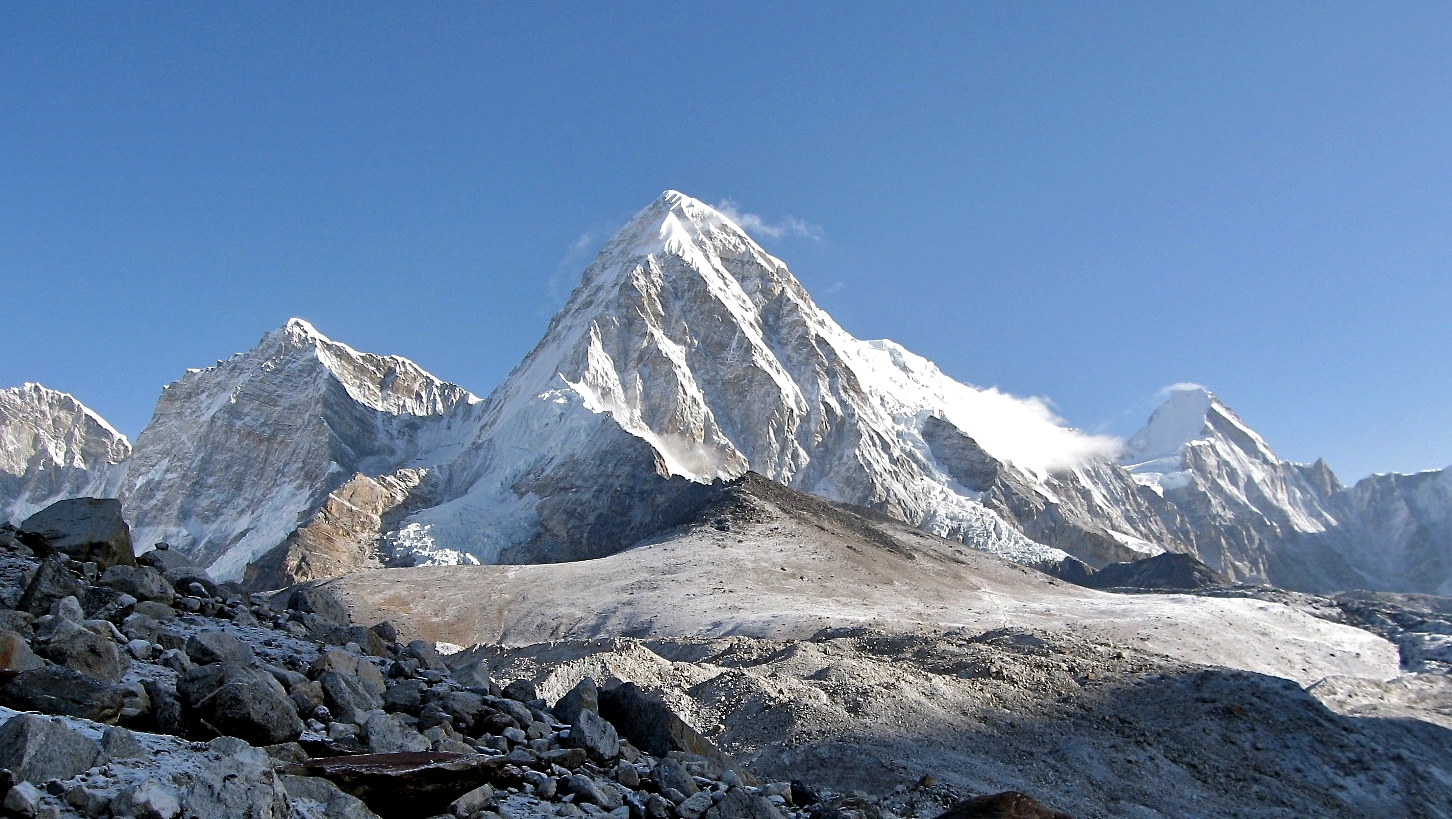
The expedition requires climbers to be in excellent physical condition and have previous experience with high-altitude climbing. It typically begins in Kathmandu, where climbers make their way to the Everest Base Camp, which serves as the starting point for the Pumori expedition. From there, the journey progresses towards establishing additional camps at strategic locations, enabling climbers to acclimatize to the increasing altitude. Ascending Pumori involves traversing challenging terrain, including technical sections with mixed rock and ice walls. Climbers must utilize their mountaineering skills and equipment to navigate these obstacles safely. The route may present crevasses, avalanches, and other hazards, demanding careful attention and adherence to safety protocols.
Summiting Pumori is a remarkable achievement, as it allows climbers to witness the awe-inspiring beauty of the Himalayas up close and personal. The expedition demands determination, skill, and resilience, but the rewards are unparalleled. The breathtaking vistas, the sense of accomplishment, and the memories forged throughout the journey make climbing Pumori a truly unforgettable experience for those who embark on this remarkable adventure.
History of the Pumori Expedition
The Pumori Expedition has a rich history with several significant climbing attempts that have shaped its legacy. The first successful ascent of Pumori took place on May 17, 1962, led by Gerhard Lenser and a German-Swiss team. This achievement marked a milestone in mountaineering history. Renowned climber Reinhold Messner further added to Pumori's reputation when he made a solo ascent of the mountain in 1982, without the use of supplemental oxygen, demonstrating his remarkable alpine-style climbing skills. Swiss climber Ueli Steck set multiple speed climbing records on Pumori, showcasing his exceptional athleticism and technical prowess. However, the mountain has also witnessed tragedies, such as the 1996 storm that claimed the lives of three climbers on Pumori's Southwest Ridge. Additionally, notable achievements include the Pumori-Nuptse Traverse completed by a Japanese team in 1997, showcasing their skill and determination. Since then, numerous expeditions have ventured to conquer Pumori, adding to its storied history and attracting climbers from around the world who seek the challenge and beauty of this extraordinary peak in the Everest region.
Highlights of the Pumori Expedition
The Pumori Expedition is a thrilling mountaineering adventure that takes climbers to the stunning peak of Pumori, located in the Everest region of Nepal. Here are some highlights of the Pumori Expedition:
- Spectacular views of the Himalayan range, including Everest, Lhotse, Nuptse, and Makalu.
- The technical challenge with mixed rock and ice sections, steep slopes, and exposed ridges.
- Starting from Lukla and trekking through the famous Everest Base Camp trail.
- Passing through Sherpa villages, dense forests, and suspension bridges.
- Navigating the treacherous Khumbu Icefall, a challenging glacier crossing.
- Establishing high camps for acclimatization at increasing altitudes.
- A physically demanding summit push to reach the summit of Pumori (7,161 meters / 23,494 feet).
- Immersion in Sherpa culture and traditions along the trekking route.
- Opportunity to visit monasteries and experience the Himalayan way of life.
- Requires careful planning, experienced guides, and proper equipment for a safe and successful climb.
Routes for the Pumori Expedition
There are several routes that climbers can take during the Pumori Expedition, each presenting its own challenges and characteristics. Here are the main routes commonly used for climbing Pumori:
Southeast Ridge
The Southeast Ridge is the most popular and commonly used route for the Pumori Expedition. It offers a challenging yet achievable ascent to the summit of Pumori. Here are the key features of the Southeast Ridge route:
Starting Point: The route begins from the Everest Base Camp (5,364 meters), where climbers trek through the beautiful Khumbu Valley, passing iconic landmarks like Namche Bazaar and Tengboche Monastery.
Khumbu Icefall: Climbers navigate through the treacherous Khumbu Icefall, a heavily crevassed section of the route. This requires careful route finding and crossing over ladders and ice bridges to safely reach Camp 1.
Western Cwm: After Camp 1, climbers enter the Western Cwm, a vast and flat glacial basin situated between Everest and Nuptse. This section involves crossing the snowfield, which can be physically demanding due to the altitude and deep snow.
Camps and Acclimatization: Along the route, climbers establish additional camps to aid in acclimatization and facilitate the climb. Camp 2 (6,400 meters) and Camp 3 (7,161 meters) are strategically positioned to allow climbers to adapt to the increasing altitude.
Southeast Ridge: From Camp 3, climbers ascend the Southeast Ridge, which involves traversing steep slopes, negotiating sections of mixed rock and ice, and using fixed ropes for safety. The route requires technical climbing skills and the use of mountaineering equipment such as crampons and ice axes.
Summit Push: The final push to the summit involves a challenging climb along the narrow ridge, often battling strong winds and extreme cold temperatures. The reward for reaching the summit is the breathtaking panoramic view of the surrounding Himalayan peaks.
The Southeast Ridge route on Pumori offers a balanced combination of technical challenges and stunning scenery.
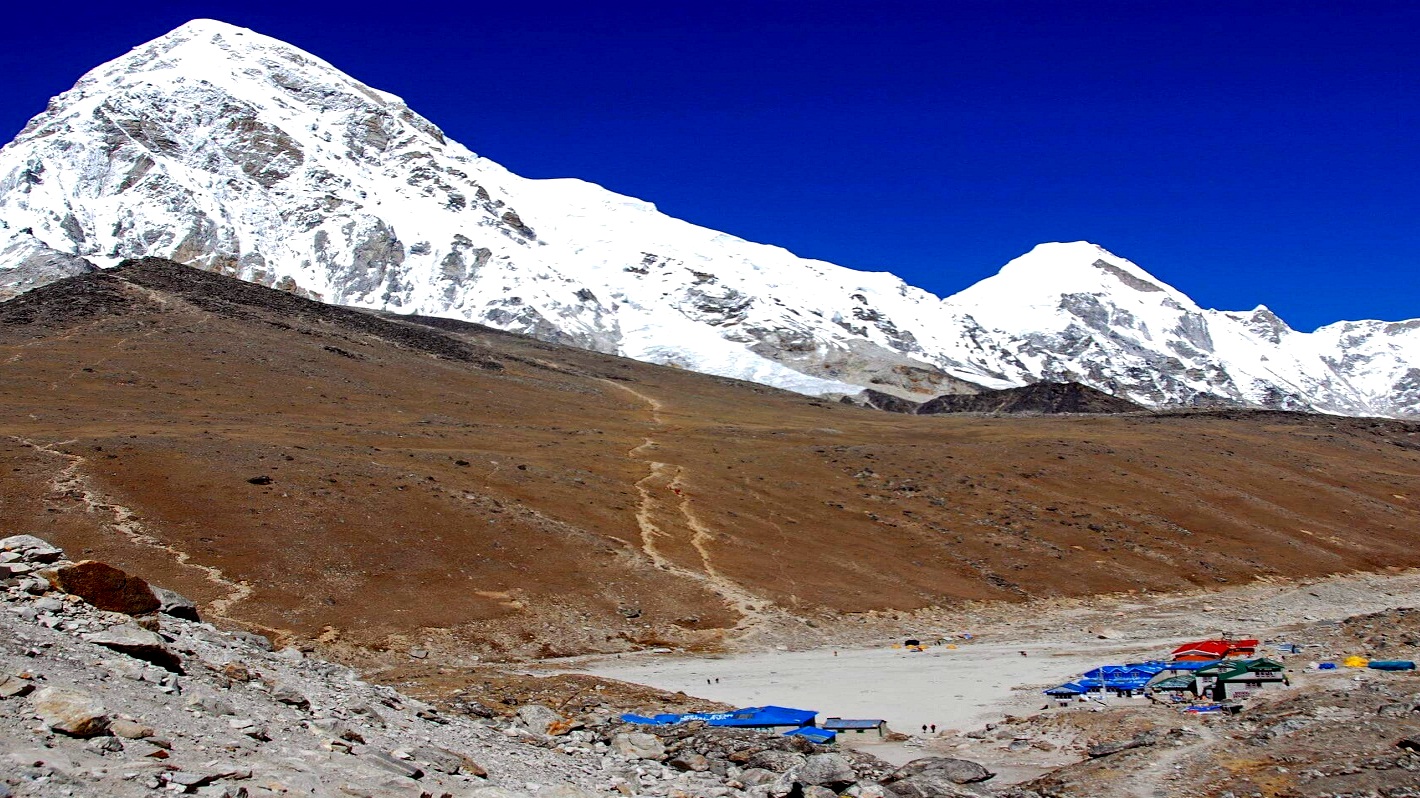
Southwest Face
The Southwest Face is an alternative route for the Pumori Expedition, offering a challenging and less-traveled ascent to the summit. Here are the key features of the Southwest Face route:
Starting Point: The route typically begins from the village of Gorak Shep (5,164 meters), which serves as the base for trekkers and climbers in the Everest region. From Gorak Shep, climbers make their way toward the base of Pumori's Southwest Face.
Direct Ascent: The Southwest Face route involves a direct ascent up the face, bypassing the Khumbu Icefall and Western Cwm sections. This makes it a more technically demanding route that requires advanced mountaineering skills.
Challenging Terrain: Climbers on the Southwest Face route encounter steep icy slopes, seracs (large ice formations), and crevasses. The route demands technical ice and mixed climbing abilities, including the use of ice axes, crampons, and other specialized equipment.
Exposure and Objective Hazards: The Southwest Face is known for its exposure to objective hazards such as avalanches and rockfall. Climbers need to assess and mitigate these risks while navigating the route.
Technical Climbing Sections: The Southwest Face route includes challenging sections of climbing, including traversing icy slopes, negotiating seracs, and ascending steep rock and ice walls. Climbers must possess good route-finding skills and the ability to assess the stability of the terrain.
Summit Push: As climbers ascend the Southwest Face, they make their way toward the summit of Pumori. The final push involves overcoming technical sections and persevering through the physical and mental challenges of high-altitude climbing.
The Southwest Face route on Pumori provides a more direct and technically demanding climb compared to other routes. It appeals to experienced climbers seeking a greater challenge and a less crowded experience. Due to the nature of the route, climbers must have excellent mountaineering skills, previous high-altitude experience, and the ability to manage objective hazards effectively. Proper equipment, careful route planning, and teamwork are vital for a safe and successful ascent via the Southwest Face.
West Ridge
The West Ridge is a more technical and demanding route that offers a direct line to the summit. It starts from the Everest Base Camp and follows the standard route until Camp 1. From there, climbers traverse the glacial basin to gain access to the West Ridge. The route involves climbing steep ice and mixed terrain, with exposure to objective hazards such as avalanches and rockfall.
North Face
The North Face route is a challenging and less-frequented option. It begins from the village of Lobuche and ascends directly up the face, requiring technical ice and mixed climbing skills. This route is steep, exposed, and subject to harsh weather conditions, making it a demanding choice for experienced climbers.
Mountain views seen during the Pumori Expedition
During the Pumori Expedition, climbers are treated to awe-inspiring views of some of the world's highest peaks and magnificent Himalayan landscapes. The most prominent among these is the iconic Mount Everest, the highest peak in the world, which stands proudly in the distance, showcasing its majestic presence. Alongside Everest, climbers can also witness the towering summits of Lhotse and Nuptse, two of the world's highest peaks that form a dramatic backdrop to the expedition. The elegant and striking silhouette of Ama Dablam, with its iconic pyramid-shaped peak, adds to the visual spectacle. As climbers traverse the terrain, they are greeted by the majestic Thamserku, a strikingly beautiful mountain that dominates the landscape with its sheer size and grandeur.
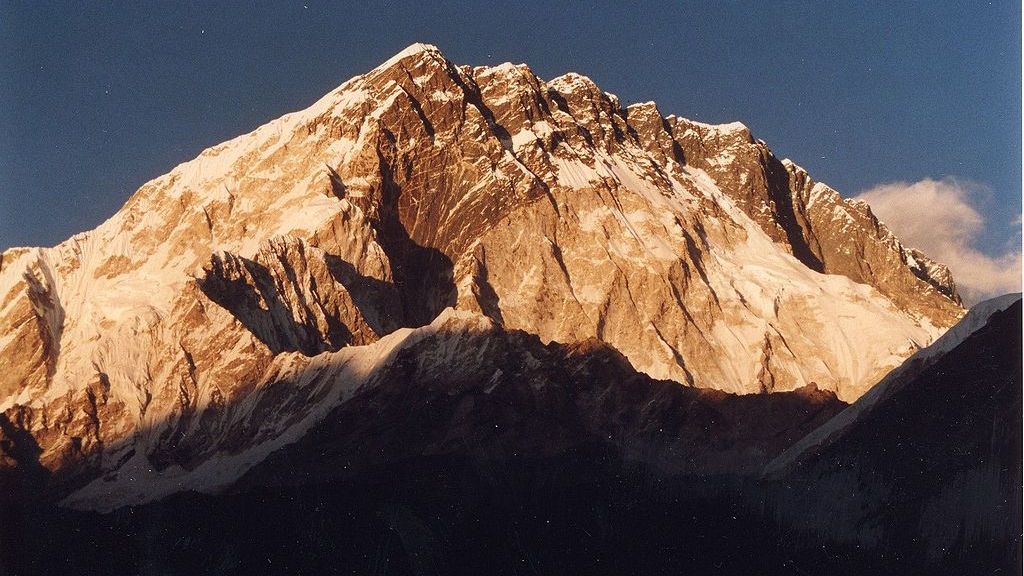
The expedition also provides stunning views of the sprawling Khumbu Glacier, one of the largest glaciers in the region, with its icy expanse glimmering under the sunlight. These incredible mountain views, accompanied by the serene Himalayan valleys and pristine glaciers, create a truly remarkable and unforgettable experience for those embarking on the Pumori Expedition, showcasing the breathtaking beauty and raw power of the Himalayas.
How Difficult Is the Pumori Expedition?
The Pumori Expedition is considered to be a highly challenging and technically demanding climb. It is rated as a difficult expedition due to several factors:
Technical Difficulty
The Pumori Expedition is known for its technical difficulty, requiring climbers to possess advanced mountaineering skills. The climb involves steep and exposed sections that demand expertise in ice climbing, rock climbing, and traversing narrow ridges. Technical gear handling, including ropes, crampons, and ice axes, is essential. Navigating through crevasses and making precise route selections adds to the technical challenge. Climbers must have a strong grasp of these skills to safely navigate the complex terrain and successfully reach the summit of Pumori.
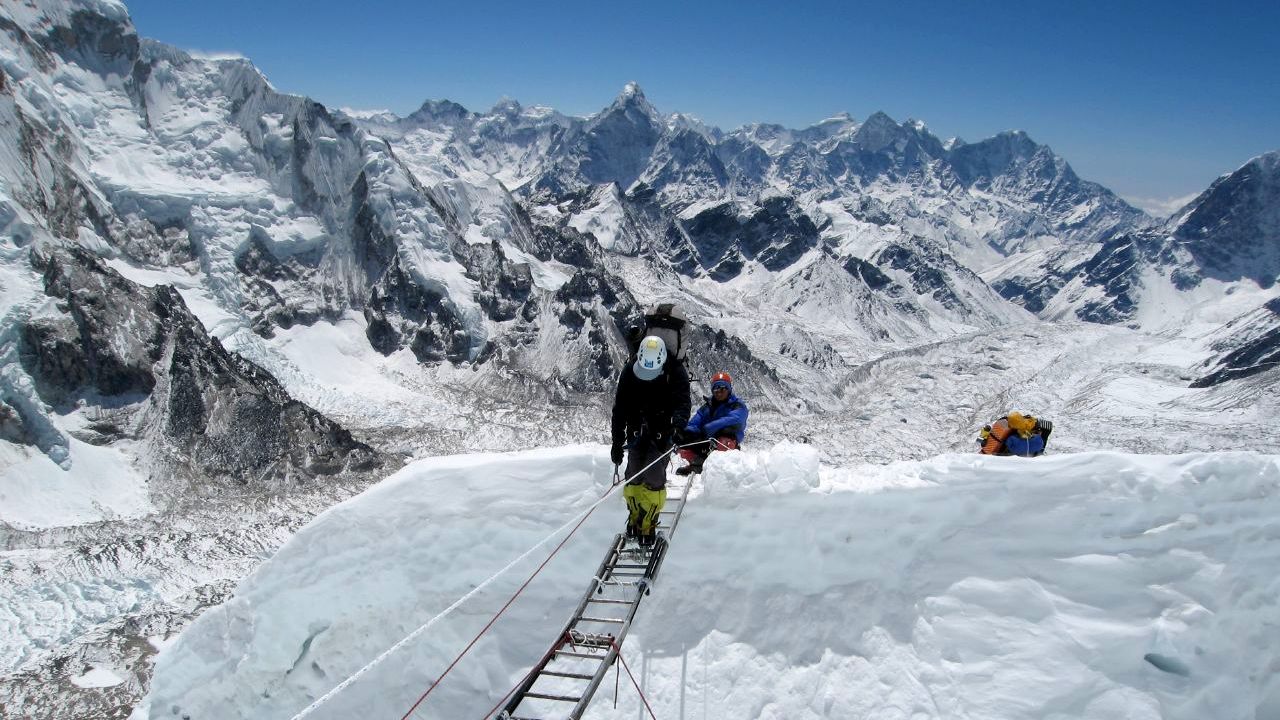
Altitude
The altitude of Pumori, standing at 7,161m (23,494ft) above sea level, adds to the difficulty of the expedition. Climbers must contend with the effects of high altitude, including reduced oxygen levels, extreme cold temperatures, and the increased risk of altitude-related illnesses such as acute mountain sickness (AMS), high-altitude pulmonary edema (HAPE), and high-altitude cerebral edema (HACE). The low-oxygen environment places a significant strain on the body, making physical exertion more challenging and increasing the risk of fatigue and exhaustion. Adequate acclimatization, proper altitude management, and a cautious approach are crucial to ensure the safety and well-being of climbers during the Pumori Expedition.
Weather Conditions
Weather conditions play a significant role in the difficulty of the Pumori Expedition. The region where Pumori is located experiences harsh and unpredictable weather patterns. Climbers must be prepared to face strong winds, heavy snowfall, extremely cold temperatures, and sudden weather changes. These conditions can significantly impact climbing conditions, visibility, and overall safety. Climbers must be equipped with proper clothing and gear to withstand extreme cold and protect against frostbite. They should also closely monitor weather forecasts and plan their ascent accordingly to maximize safety and increase the chances of a successful summit bid. Flexibility in scheduling and being prepared for potential weather-related delays or challenges is essential during the Pumori Expedition.
Expedition Duration
The duration of the Pumori Expedition can vary depending on various factors such as climber experience, weather conditions, and logistical considerations. Typically, the expedition takes several weeks to complete. The climb involves establishing multiple camps at different elevations, allowing for acclimatization and gradual progress towards the summit. Climbers spend time at base camp for preparation and acclimatization before moving to higher camps. The ascent itself may take several days, including rest days and summit attempts. The length of the expedition also accounts for weather contingencies, rest periods, and descent back to base camp. The extended duration of the Pumori Expedition requires climbers to have the physical endurance, mental resilience, and logistical support necessary to endure the challenging mountain environment over an extended period.
How to prepare for the Pumori Expedition
To prepare for the Pumori Expedition, start by focusing on your physical fitness. Engage in a well-rounded training regimen that includes cardiovascular exercises, strength training, and endurance activities. Emphasize leg and core strength, as well as aerobic fitness, to cope with the demanding climb. Acclimatization is crucial, so plan trips to higher altitudes to adapt your body to lower oxygen levels. Developing advanced mountaineering skills is essential, including proficiency in ice climbing, rock climbing, and technical gear handling. Consider joining mountaineering courses or hiring experienced guides to learn and practice these skills. Mental preparation is equally important. Cultivate a strong mindset, resilience, and decision-making abilities to face the challenges and uncertainties of the climb. Lastly, ensure you have the necessary gear and equipment, including high-quality clothing, mountaineering gear, and supplies. Plan your logistics, including permits, transportation, and accommodation well in advance. By focusing on physical, technical, and mental readiness, you can increase your chances of a safe and successful Pumori Expedition.
Permits for the Pumori Expedition
To undertake the Pumori Expedition, climbers are required to obtain certain permits and permissions. Here are the key permits you will need:
Sagarmatha National Park Permit: Pumori is located within the Sagarmatha National Park in Nepal. All climbers must obtain a Sagarmatha National Park Permit. This permit can be obtained from the Department of Immigration in Kathmandu or through registered trekking agencies.
Climbing Permit: A climbing permit specifically for Pumori is required from the Nepal Mountaineering Association (NMA). The NMA sets the fees and regulations for climbing peaks in Nepal. You can apply for the climbing permit through a registered trekking agency or directly at the NMA office in Kathmandu.
Liaison Officer: As part of the permit requirements, you may need to hire a Liaison Officer from the NMA or the Ministry of Tourism. The Liaison Officer accompanies you during the expedition to ensure compliance with regulations and acts as a point of contact between climbers and local authorities.
It is essential to apply for these permits well in advance of your planned expedition dates. Working with a reputable trekking agency or expedition operator can streamline the permit application process and ensure all necessary documentation is in order. Remember to carry the permits and relevant identification documents during the expedition as they may be checked at various checkpoints.
Best Season For Pumori Expedition
The best season for the Pumori Expedition is typically during the spring and autumn months, which offer the most favorable weather and climbing conditions. however, all four seasons have their own advantage and disadvantages:
Spring (Late March to Early June)
This is the most popular time to climb Pumori and other high-altitude peaks in the Himalayas. The temperatures, although still cold, are more manageable and the winds are less severe than during other parts of the year. Weather conditions tend to be more predictable in the spring, allowing for safer and more successful summit attempts. However, weather in the mountains can change rapidly, so climbers should always be prepared for unexpected conditions.
Base Camp: Daytime temperatures can be around 10-15°C (50-59°F) on a sunny day but drop to -5 to -10°C (23-14°F) at night.
High Camps: Daytime temperatures can be around -10 to -20°C (14 to -4°F) and can drop to -20 to -30°C (-4 to -22°F) at night.
Summer (June to August)
This is monsoon season in Nepal and is generally considered the least favorable time for climbing Pumori. The region experiences heavy rainfall, and the upper sections of the mountain can get a significant amount of snow. These conditions can increase the risk of avalanches, landslides, and other hazards. The paths become slippery and visibility is reduced, making climbing difficult and dangerous.
Base Camp: Daytime temperatures can reach 15-20°C (59-68°F) but can drop to 0 to -5°C (32-23°F) at night.
High Camps: Daytime temperatures can hover around -5 to -15°C (23 to 5°F) and can drop to -15 to -25°C (5 to -13°F) at night.
Autumn (Late September to Early November)
The autumn season is the second most popular time to climb Pumori. After the monsoon, the skies usually clear up, making way for spectacular views of the surrounding peaks. The weather is generally stable and dry, but it can be colder than in the spring, especially during the nights. Summit windows can also be shorter in autumn, so climbers need to be well-acclimatized and ready to make the most of good weather when it comes.
Base Camp: Daytime temperatures can be around 10-15°C (50-59°F) on a sunny day but drop to -10 to -15°C (14-5°F) at night.
High Camps: Daytime temperatures can be around -15 to -25°C (5 to -13°F) and can drop to -25 to -35°C (-13 to -31°F) at night.
Winter (December to February)
Winter is also a challenging time for a Pumori expedition. Temperatures drop significantly, and severe storms are frequent, making climbing conditions extreme and risky. The cold, combined with high winds, can make even the most straightforward sections of the climb dangerous. Only highly experienced climbers with the appropriate gear should consider a winter ascent, and even then, it's considered very challenging and risky.
Base Camp: Daytime temperatures can be around -5 to 0°C (23-32°F) and can drop to -15 to -20°C (5 to -4°F) at night.
High Camps: Daytime temperatures can be around -20 to -30°C (-4 to -22°F) and can drop to -30 to -40°C (-22 to -40°F) at night.
Remember, regardless of the season, a Pumori expedition is a significant undertaking that requires a high level of physical fitness, technical climbing skills, and a thorough understanding of high-altitude environments. It's crucial to be well-prepared and to make safety a top priority. Always be part of a well-organized expedition, preferably with experienced guides, and have comprehensive rescue and travel insurance.
Accommodation and Meals During The Pumori Expedition
Accommodations and meals during a Pumori Expedition vary depending on the different stages of the climb, the nature of the terrain, and the logistics of carrying and preparing food at different altitudes. Here's what you might typically expect:
Accommodation
Teahouse
The trek to Pumori Base Camp usually goes through the Khumbu region, where accommodations are in teahouses and lodges in the local villages. These teahouses offer basic facilities: beds in shared rooms, common toilets, and sometimes hot showers for an additional fee. These accommodations are comfortable but relatively basic, as they are located in remote regions.
Base Camp and High Camps
Once you reach the Base Camp, accommodation is in tents. Your expedition team will set up a camp that serves as your home away from home during the climb. You will sleep in specially designed high-altitude tents that are built to withstand harsh weather conditions. It's important to have a good quality down sleeping bag rated for extreme cold to ensure you stay warm during the night.
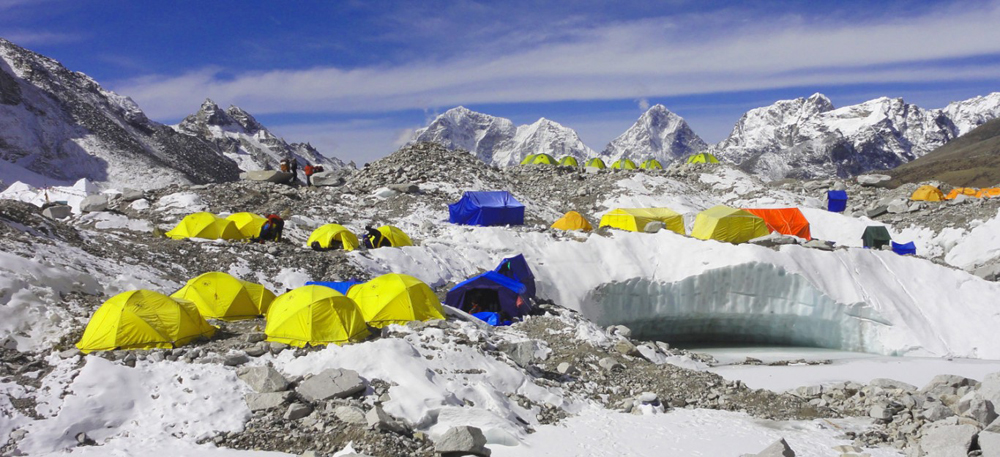
The same goes for the High Camps on the mountain – accommodations are in mountaineering tents. These are typically smaller and more basic than those at Base Camp because they must be carried up the mountain and withstand harsh conditions.
Meals
Teahouse
During the trek to Base Camp, meals are usually served in teahouses or lodges where you'll be staying overnight. Typical food includes local Nepalese dishes, like Dal Bhat (lentil soup, rice, and curried vegetables), as well as pasta, potatoes, vegetables, cereals, eggs, and simple meat dishes. There might also be options for pizzas and pancakes. It's essential to maintain a balanced diet to sustain energy for the trek.
At Base Camp and High Camps
Once you're at Base Camp and the High Camps, meals are prepared by the expedition's cook team. Breakfast might include items like porridge, cereals, pancakes, eggs, and coffee or tea. Lunch and dinner often consist of a mix of local and Western food - soups, pasta, rice, lentils, vegetables, tinned meat, bread, and sometimes even fresh food air-dropped from lower altitudes.
Throughout the expedition, hydration is key, so plenty of hot water will be available for making tea, coffee, hot chocolate, or just filling your water bottles. In the high camps, meals might be more basic due to the need to carry food and cooking equipment up the mountain.
It's important to note that the specific arrangements for accommodation and meals can vary depending on the expedition organizer and the level of service chosen. It is advisable to communicate with the expedition team or trekking agency in advance to understand the details of accommodation and meal provisions during the Pumori Expedition.
Travel Insurance for the Pumori Expedition
When undertaking the Pumori Expedition or any other mountaineering adventure, having comprehensive travel insurance is highly recommended. Here are some important factors to consider regarding travel insurance for the Pumori Expedition:
- Coverage for High-Altitude Climbing: Ensure that your travel insurance specifically covers high-altitude mountaineering activities, including the specific altitude range of Pumori. Some insurance policies may have altitude limits or exclusions, so it's crucial to choose a policy that explicitly includes coverage for the altitudes you will be climbing.
- Emergency Medical Expenses: Look for a policy that provides coverage for emergency medical expenses, including medical evacuation and rescue operations. Mountaineering involves inherent risks, and in case of injuries or altitude-related illnesses, having adequate coverage for medical expenses is crucial.
- Trip Cancellation or Interruption: Consider a policy that covers trip cancellation or interruption due to unforeseen circumstances such as injury, illness, or natural disasters. This coverage can help you recover costs associated with prepaid expenses such as flights, accommodations, and expedition fees.
- Equipment Coverage: Depending on the value of your personal equipment and gear, it may be wise to opt for a policy that offers coverage for loss, theft, or damage to your equipment during the expedition.
- Personal Liability: Having personal liability coverage can be important in case of accidents or damages caused to others during the expedition. This coverage can protect you in the event of a legal claim.
- Pre-existing Medical Conditions: If you have any pre-existing medical conditions, make sure to disclose them to the insurance provider and understand how they will be covered during the expedition.
- Read the Policy Details: Carefully read and understand the terms, conditions, and exclusions of the insurance policy. Be aware of any deductibles, claim procedures, and documentation requirements.
It is crucial to choose a reputable insurance provider and discuss your specific needs with them to ensure you have appropriate coverage for the Pumori Expedition. Keep all necessary documents and contact information readily accessible during your climb in case of any emergencies. Remember that travel insurance is an essential aspect of your expedition preparation, providing peace of mind and financial protection in unforeseen situations.
Checklist for the Pumori Expedition
Here is a checklist of essential items to consider for the Pumori Expedition:
Climbing Gear
- Mountaineering boots
- Crampons
- Ice axe
- Harness
- Helmet
- Climbing rope
- Carabiners and quickdraws
- Ascenders or Jumars
- Belay device
- Prusik cords
- Mountaineering backpack
Clothing
- Base layers (moisture-wicking shirts and pants)
- Insulating layers (fleece or down jacket)
- Waterproof and windproof shell jacket
- Waterproof and windproof shell pants
- Insulated pants or bibs
- Gaiters
- Gloves (insulated and waterproof)
- Warm hat
- Balaclava or neck gaiter
- Sunglasses with UV protection
- Mountaineering socks
Camping and Sleeping Gear
- Four-season tent
- Sleeping bag (rated for extreme temperatures)
- Sleeping pad or mat
- Trekking poles
Technical Equipment
- GPS device and/or altimeter
- Map and compass
- Headlamp with extra batteries
- Multi-tool or knife
- First aid kit
- Climbing helmet
- Sunscreen (high SPF)
- Lip balm with SPF
- Water purification systems or tablets
- Water bottles or hydration bladder
- High-calorie snacks and energy bars
- Personal toiletries (toilet paper, wet wipes, hand sanitizer)
Personal Items
- Passport and necessary travel documents
- Cash and credit cards
- Personal medications and prescriptions
- Travel insurance documents
- Camera or video equipment
- Extra memory cards and batteries
- Portable charger or power bank
Communication and Safety
- Two-way radios or satellite phone
- Whistle
- Signal mirror
- Emergency blanket
- Duct tape or repair kit
Remember to check with your expedition organizer or guide for any specific gear or equipment requirements for the Pumori Expedition. It is crucial to have high-quality and well-maintained gear to ensure your safety and comfort during the climb. Make sure to thoroughly test and familiarize yourself with all equipment before the expedition.
Tips for the Pumori Expedition
Here are some tips to help you prepare for the Pumori Expedition:
- Prioritize physical fitness and endurance training.
- Allow sufficient time for altitude acclimatization.
- Develop and improve your mountaineering skills.
- Invest in high-quality and properly fitted mountaineering gear.
- Foster good communication and teamwork with your climbing partners.
- Mentally prepare yourself for the challenges ahead.
- Stay informed about weather conditions and plan your ascent accordingly.
- Maintain proper hydration and nutrition throughout the expedition.
- Follow safety protocols and guidelines from experienced climbers.
- Respect the mountain environment and practice Leave No Trace principles.
Remember to thoroughly research and consult with experienced climbers or guides for a more detailed understanding of each tip and how it applies to your specific circumstances.
FAQ (Frequently Asked Questions) for Pumori Expedition in Nepal
Q: What is the elevation of Pumori?
A: Pumori stands at an elevation of 7,161m (23,494ft) above sea level.
Q: Where is Pumori located?
A: Pumori is located in the Mahalangur section of the Himalayas, on the Nepal-Tibet border.
Q: Is Pumori a technically challenging peak?
A: Yes, Pumori is considered a technically challenging peak, requiring mountaineering skills, ice climbing experience, and knowledge of roped glacier travel.
Q: What is the best time to climb Pumori?
A: The best time to climb Pumori is generally during the pre-monsoon (spring) season from April to May and the post-monsoon (autumn) season from September to November. These seasons offer more stable weather and better climbing conditions.
Q: Do I need prior climbing experience to attempt Pumori?
A: Yes, prior mountaineering experience is highly recommended. Climbers should have previous high-altitude climbing experience, knowledge of technical mountaineering skills, and familiarity with using climbing equipment.
Q: Are permits required for the Pumori Expedition?
A: Yes, climbers need to obtain a climbing permit from the Nepal Mountaineering Association (NMA) to climb Pumori. Additionally, a Sagarmatha National Park entry permit is also required.
Q: Do I need a guide for the Pumori Expedition?
A: While it is not mandatory to have a guide, it is highly recommended, especially for climbers without extensive experience in high-altitude mountaineering. A qualified guide can provide support, safety, and route guidance.
Q: How long does the Pumori Expedition take?
A: The duration of the Pumori Expedition can vary depending on several factors, including acclimatization time, weather conditions, and individual climbing pace. On average, it takes around 4-6 weeks to complete the expedition, including travel, preparation, and climbing.
Q: What are the accommodation options during the Pumori Expedition?
A: Accommodation during the expedition includes tents at base camp and higher camps. Base Camp generally has more established facilities, including dining tents, while higher camps have more basic tent setups.
Q: What are the risks and challenges associated with climbing Pumori?
A: Some of the risks and challenges of climbing Pumori include high altitude, extreme weather conditions, technical sections, crevasses, avalanches, and potential health issues such as altitude sickness. Proper preparation, training, and experienced guidance are crucial for mitigating these risks.
Similarly other 7000-meter peaks for Climbing and Expedition Packages in Nepal
Tilicho Peak Expedition (7,134 m)
Gangapurna Expedition (7,455 m)
Annapurna South Expedition (7,219 m)
8000-meter Mountain Expedition in Nepal
Makalu Expedition (8,463m)
Manaslu Expedition (8,163 m)
Kanchenjunga Expedition (8,586 m)
Lhotse Expedition (8,516 m)
Mt. Everest Expedition (8848.86 m)
Dhaulagiri Expedition (8,167 m)
6000-meter peaks for Climbing and Expedition in Nepal
Mt Ama Dablam Expedition (6,812 m)
Island Peak Expedition (6,160 m)
Mera Peak Climbing (6,476 m)
Chulu West Peak Climbing (6,419 m)
Pisang Peak Climbing (6,091 m)
Singu Chuli Peak Climbing (6,501 m)
If you need any further information, please contact us by email: at [email protected], Phone: at +977- 985 100 5129 (WhatsApp)
#Tags
Tripadvisor
5.0928 reviewsGoogle
4.8114 reviewsFacebook
4.1 recommend44 ReviewsTrustpilot
4.1 Great(5 reviews)- Trusted by50K plus traveller




